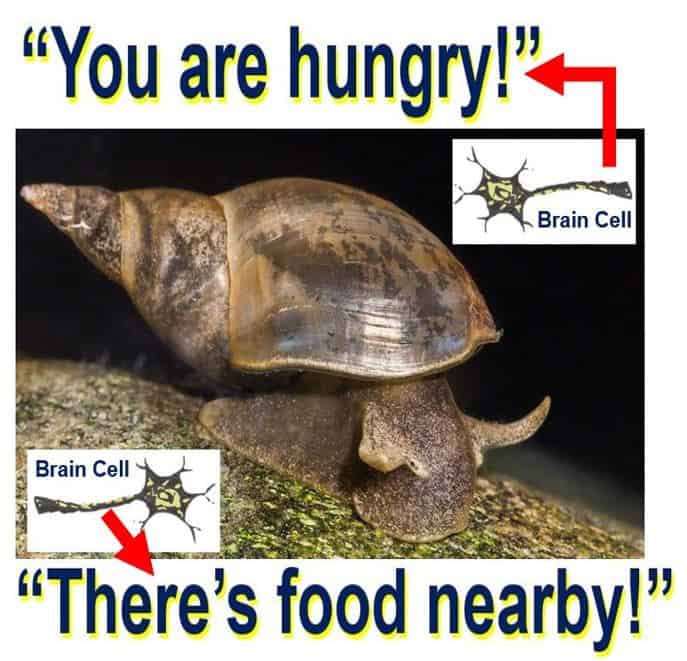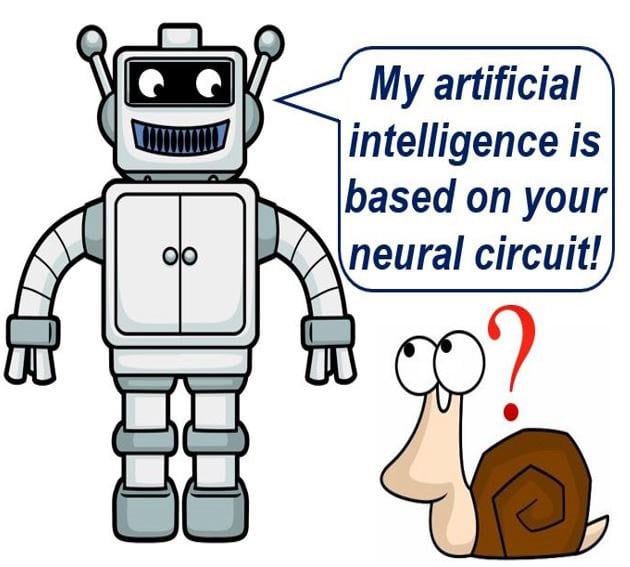If snails use just two brain cells to make decisions, robot brains could be created along the same lines, say scientists from the University of East Sussex, England. When designing a robot’s brain, artificial intelligence engineers want the fewest components possible to be able to perform complex tasks – something that the snail manages to do with only two neurons.
In the snail’s case, one brain cell tells it that it is hungry, while the second informs whether there is food present.
György Kemenes, Kevin Staras and Michael Crossley wrote about their study on snails in the journal Nature Communications. They explain how they discovered that with just two neurons, snails are able to make complex behavioural decisions.
 One brain cell (neuron) tells the snail it is hungry, while the other informs that there is food nearby. (Image: adapted from oikosjournal.org)
One brain cell (neuron) tells the snail it is hungry, while the other informs that there is food nearby. (Image: adapted from oikosjournal.org)
Complex decision-making with just two brain cells
The researchers studied the brain activity of freshwater snails (Lymnaea stagnalis) and discovered how a two-brain-cell circuit was capable of a sophisticated form of decision-making.
The authors, from Sussex Neuroscience, part of Sussex University’s School of Life Sciences, observed the behaviour of snails when they made decisions in their search for food, which in their experiment was lettuce.
What is a robot?
They measured the snails’ brain activity by using electrodes to record action potentials – very small electrical changes – in individual neurons.
Two types of neurons were discovered:
1. A control type of brain cell (neuron) that tells the brain that there is potential food nearby.
2. Another type of brain cell that transmits signals that tell the brain about its motivational state – whether it is hungry or not.
 The scientists who discovered that snails use just two brain cells for making important decisions believe their findings could help engineers design more efficient robots.
The scientists who discovered that snails use just two brain cells for making important decisions believe their findings could help engineers design more efficient robots.
An amazingly efficient system
The authors also explain how the two-brain-cell system enables the snail to save energy by minimising brain activity when there is no food about.
Professor of Neuroscience George Kemenes, who led the study, said:
“What goes on in our brains when we make complex behavioural decisions and carry them out is poorly understood. Our study reveals for the first-time how just two neurons can create a mechanism in an animal’s brain which drives and optimizes complex decision making tasks.”
“It also shows how this system helps to manage how much energy they use once they have made a decision.”
Snail brains could inspire robot brain creation
Prof. Kemenes and colleagues believe their findings could help artificial intelligence designers identify core neuronal systems which underlie other similar decision-making processes.
Prof. Kemenes added:
“This will eventually help us design the ‘brains’ of robots based on the principle of using the fewest possible components necessary to perform complex tasks.”
 (Left) György Kemenes, (Middle) Kevin Staras and Michael Crossley (Images: University of Sussex)
(Left) György Kemenes, (Middle) Kevin Staras and Michael Crossley (Images: University of Sussex)
Several goal-directed behaviours, including seeking food, are necessary for all animals to survive. When we and other creatures search for food, our neuronal systems must integrate data about both our external environment and internal state in order to find food – this has to be done efficiently; using as little energy as possible.
In an Abstract which describes the main article in the journal, the authors wrote:
“Using an in vitro analogue of the decision-making process, we show that the system employs an energy management strategy, switching between a low- and high-use mode depending on the outcome of the decision.”
“Our study reveals a parsimonious mechanism that drives a complex decision-making process via regulation of levels of tonic inhibition and phasic excitation.”
Reference: “A two-neuron system for adaptive goal-directed decision-making in Lymnaea,” Kevin Staras, Michael Crossley and György Kemenes. Nature Communications. DOI:10.1038/ncomms11793.
Video – Artificial Intelligence
Artificial intelligence refers to software technologies that make robots and other machines mimic human thinking and behavior.
